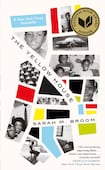
Sarah M Broom’s memoir was first published in the US last year to great acclaim. The Yellow House won the National Book Award for Nonfiction, and was widely cited as essential reading, a “major book”.
The memoir arrives in Europe at a moment when two of its themes are in particularly intense public focus. The story of a family home in eastern New Orleans devastated by Hurricane Katrina, Broom’s narrative registers the consequences of a large-scale political negligence once again starkly evident in the US response to the coronavirus outbreak.
The genealogy – going back to the second decade of the 20th century – of a black family in a city whose tourist-oriented, sometimes dubiously nostalgic image has often been maintained “at the expense of its native black people”, the book also appears just as protests over lethal police violence against African-Americans prompt critical scrutiny of racial attitudes on this side of the Atlantic.
A reminder of the entwinement of Irish history with the institution of slavery comes in Broom’s mention of the fact that her grandmother was born on “Ormond Plantation, named after an Irish castle”, in Destrehan, Louisiana.
Recounting the schooldays of the previous generation, she refers to John McDonogh, a slave-owner of Ulster origins who was the benefactor of the New Orleans education system and the object of a hierarchically segregated day of homage until 1954, when black teachers and students boycotted a ritual denounced by local civil rights leaders as one of humiliation and shame.
Broom’s memoir creates an unusual suspense: what kind of personal chronicle is it? Will this be an excavation of childhood suffering, of trauma? Is it the story of the gifted scion of a “provincial” environment who departs for the opportunities of some more alluring “centre”?
American history
US reviewers praised the book for transcending the autobiographical genre, weaving together the past of a family, a city, and a nation, expanding “the collective understanding of American history”.
Her project and methods have been aligned with scholarly efforts in the last half-century to restore the record of experiences and legacies ignored or suppressed by a white-colonial perspective. While these are deserved accolades for a landmark achievement, they signpost no arduous journey for the reader.
Well positioned, as the youngest of 12 siblings, to be the curious researcher of her own background, Broom fashions a dynamic archive of voice, visual image, documentary evidence. The investigator moves across spaces and reconstructions of lost time to understand a dual heritage of belonging and dispossession.
Mapping the fate of a 1960s promise of urban development and integration, The Yellow House also seeks out a “global context” for the treatment of the Katrina-displaced, who were denominated by some in the US media “refugees” in their own country.
Analysis unfolds in part through testimony. The most influential of the speakers and the owner of the eponymous house, the author’s mother, Ivory Mae, advises on sensibility: “When we talk and if something doesn’t go in a straight line, y’all want to stop. Y’all patience wear out. Like y’all already got it planned in your mind, how the story gonna go.… We have to be quiet and invite someone not so upfront to say something.”
Broom’s detailed cartography encompasses less widely known spheres of her city and of the American narrative: property and slave-owning free women of colour in the French Quarter of the late 18th century; a black upper-class suburban gated community further east of the ambiguous industrial-residential zone in which she grew up.
Her strategy of allowing remembered remarks and scenes to speak for themselves has an especially striking effect in the portrayal of family members. An absence of the kind of condemnatory or approving appraisal that is often a driving feature of memoir generates a powerful sense of life – and of love, if the book were so sentimental – as a pattern of physical and psychical proximity.
This is most obvious in the depiction of her brother Carl, the guardian of the yellow house, who stays there during Katrina, visits the ruins, and returns to tend the vacant lot after a mandated demolition. His trajectory gives the book its central arc: gathering the shared sensory impressions that constitute identity even after their material sources have disappeared.
The frequent portrayal of action or quotation of utterance without overt evaluative commentary offers a wry angle on the “anthropological, academic language” through which Broom at one point seeks to grasp her family’s disaster, and on the surreal period she spends working for the now-disgraced former mayor of New Orleans, C Ray Nagin.
Humour
In addition to the “deadpan humour” noted by her US reviewers, Broom’s sentences generate an absorbing enjoyment. Culminating moments of indictment rise to an incantatory lyricism:
“Those of us who were born to New Orleans already knew its underbelly. Storms, of all sorts, were facts of our lives. Those images shown on the news of fellow citizens drowned, abandoned, and calling for help were not news to us, but still further evidence of what we long ago knew. … I knew it at Livingston Middle School when I did not learn because no one was teaching me. I knew it in 1994, when we were petrified, afraid the law might kill us –knew it before, during, and after the Water.”
The Yellow House is not a book to consult for political prescriptions. At times it might leave the reader wondering whether the inner workings of municipal governance could ever really be elusive to quite the degree that Broom suggests.
Without any outline of the nature of relations between the state and private enterprise, her conclusions about what ought to have been done differently can seem merely wishful. But the memoir remains an engrossing account of the concrete realities, and dangerous chimeras, of what its author resonantly calls “an unequal, masquerading world”.













